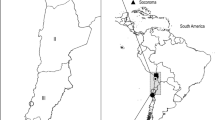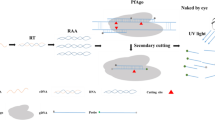Abstract
Echinococcus multilocularis is one of the most relevant zoonotic parasites with about 18,000 human cases per year. Its detection in wild host is crucial for disease prevention. The present study aimed to determine factors affecting the sensitivity of E. multilocularis detection by PCR using DNA extracted from fecal samples of coyotes (Canis latrans). Fecal samples were screened for the presence of Taeniidae eggs through centrifugation and sedimentation. DNA was extracted from fecal samples with and without prior freeze-thawing of the sample and then subjected to PCR targeting a mitochondrial gene (nad1) and a multi-loci microsatellite marker (EmsB). The presence of PCR inhibitors was determined through internal amplification control. Subjecting the sample to repeated freeze-thaw cycles significantly increased the sensitivity of the PCR by 20 %. Likewise, egg intensity had a significant effect on PCR, an effect which was more pronounced for samples not subjected to freeze-thawing. Two or more eggs per gram of feces significantly increased the odds for a positive PCR outcome. The presence of PCR inhibitors had no effect on PCR in samples subjected to freeze-thaw cycles, whereas in samples not subjected to freeze-thaw cycles, the presence of PCR inhibitors was associated with a 0.78 lower odds ratio of positive PCR outcome. Targeting a nuclear versus a mitochondrial gene did not have a significant effect on the sensitivity of PCR. We recommend freeze-thawing samples prior to DNA extraction to become a standard procedure for E. multilocularis detection in canid feces.


Similar content being viewed by others
References
Al-Soud WA, Radstrom P (2001) Purification and characterization of PCR-inhibitory components in blood cells. J Clin Microbiol 39(2):485–493. doi:10.1128/JCM.39.2.485-493.2001
Bart JM et al (2006) EmsB, a tandem repeated multi-loci microsatellite, new tool to investigate the genetic diversity of Echinococcus multilocularis. Infect, Gen Evol: J Mol Epidemiol Evol Gen Infect Dis 6(5):390–400. doi:10.1016/j.meegid.2006.01.006
Beiromvand M et al (2011) Detection of Echinococcus multilocularis in carnivores in Razavi Khorasan province, Iran using mitochondrial DNA. PLoS Negl Trop Dis 5(11):e1379. doi:10.1371/journal.pntd.0001379
Craig PS, Rogan MT, Allan JC (1996) Detection, screening and community epidemiology of taeniid cestode zoonoses: cystic echinococcosis, alveolar echinococcosis and neurocysticercosis. Adv Parasitol 38:169–250
Davidson RK, Oines O, Madslien K, Mathis A (2009) Echinococcus multilocularis—adaptation of a worm egg isolation procedure coupled with a multiplex PCR assay to carry out large-scale screening of red foxes (Vulpes vulpes) in Norway. Parasitol Res 104(3):509–514. doi:10.1007/s00436-008-1222-y
Deer DM, Lampel KA, Gonzalez-Escalona N (2010) A versatile internal control for use as DNA in real-time PCR and as RNA in real-time reverse transcription PCR assays. Lett Appl Microbiol 50(4):366–372. doi:10.1111/j.1472-765X.2010.02804.x
Dinkel A, von Nickisch-Rosenegk M, Bilger B, Merli M, Lucius R, Romig T (1998) Detection of Echinococcus multilocularis in the definitive host: coprodiagnosis by PCR as an alternative to necropsy. J Clin Microbiol 36(7):1871–1876
Eckert J, Gemmell MA, Meslin F-X, Pawłowski ZS (2001) WHO/OIE manual on echinococcosis in humans and animals: a public health problem of global concern. World Organisation for Animal Health, France
Good P (2000) Permutation tests: a practical guide to resampling methods for testing hypotheses, 2nd edn. Springer Verlag, New York
Hosmer DW, Lemeshow S, Sturdivant RX (2013) Applied logistic regression. Wiley, New York
Karamon J (2014) Detection of Echinococcus multilocularis in faeces by nested PCR with the use of diluted DNA samples. Pol J Vet Sci 17(1):79–83
Jones A, Pybus MJ (2008) Taeniasis and echinococcosis. In: Samuel WM, Pybus MJ, Kocan AA (eds) Parasitic diseases of wild mammals (Second Edition). Iowa State University Press, p 150-192
Liccioli S, Kutz SJ, Ruckstuhl KE, Massolo A (2014) Spatial heterogeneity and temporal variations in Echinococcus multilocularis infections in wild hosts in a North American urban setting. Int J Parasitol 44(7):457–465
Mehta CR, Patel NR (1996) SPSS Exact Tests 7.0 for Windows®. SPSS Inc, Chicago
Monteiro L et al (1997) Complex polysaccharides as PCR inhibitors in feces: Helicobacter pylori model. J Clin Microbiol 35(4):995–998
Nonaka N, Tsukada H, Abe N, Oku Y, Kamiya M (1998) Monitoring of Echinococcus multilocularis infection in red foxes in Shiretoko, Japan, by coproantigen detection. Parasitology 117(Pt 2):193–200
Oikarinen S et al (2009) PCR inhibition in stool samples in relation to age of infants. J Clin Virol: Off Publ Pan Am Soc Clin Virol 44(3):211–214
Raoul F, Deplazes P, Rieffel D, Lambert J-C, Giraudoux P (2010) Predator dietary response to prey density variation and consequences for cestode transmission. Oecologia (Berlin) 164(1):129–139. doi:10.1007/s00442-010-1647-8
Ruecker NJ, Bounsombath N, Wallis P, Ong CSL, Isaac-Renton JL, Neumann NF (2005) Molecular forensic profiling of Cryptosporidium species and genotypes in raw water. Appl Environ Microbiol 71(12):8991–8994. doi:10.1124/aem.71.12.8991-8994.2005
Trachsel D, Deplazes P, Mathis A (2007) Identification of taeniid eggs in the faeces from carnivores based on multiplex PCR using targets in mitochondrial DNA. Parasitology 134(Part 6):911–920. doi:10.1017/s0031182007002235
Waits LP, Paetkau D (2005) Noninvasive genetic sampling tools for wildlife biologists: a review of applications and recommendations for accurate data collection. J Wildl Manag 69(4):1419–1433
Acknowledgments
We thank Drs. N Neuman and G. Banting for their support with the plasmid construct. We thank all the undergraduate students that participated in our study for their passion and commitment.
Canadian Council of Health Research CIHR (funding reference, 201011GIR-239508-IRG-CBBA-51314 dt 24/06/2011), Institute for Public Health of the Alberta Health, and Alberta Innovates Health Solutions (AIHS) contributed to operational funding. Student salary was covered by studentships of the University of Calgary, Department of Ecosystem & Public Health (Faculty of Veterinary Medicine, University of Calgary), andAlberta Innovates Health Solutions, The City of Calgary Parks covered part of the operational costs and provided in-kind contribution and logistic support.
Conflict of interest
The authors declare that they have no competing interests.
Ethical standards
The material presented in this paper has not been published or submitted for publication elsewhere, and there is no overlap with other articles or abstracts published or in press in journals, books, or in preparation. The research has been approved by the Veterinary Science Animal Care Committee of the University of Calgary, AB, Canada (protocol number AC13-0199).
Author information
Authors and Affiliations
Corresponding author
Rights and permissions
About this article
Cite this article
Klein, C., Liccioli, S. & Massolo, A. Egg intensity and freeze-thawing of fecal samples affect sensitivity of Echinococcus multilocularis detection by PCR. Parasitol Res 113, 3867–3873 (2014). https://doi.org/10.1007/s00436-014-4055-x
Received:
Accepted:
Published:
Issue Date:
DOI: https://doi.org/10.1007/s00436-014-4055-x




